Archive for ‘Pandemic’ Category
Divide and Conquer: Improve Productivity With Privacy Screens
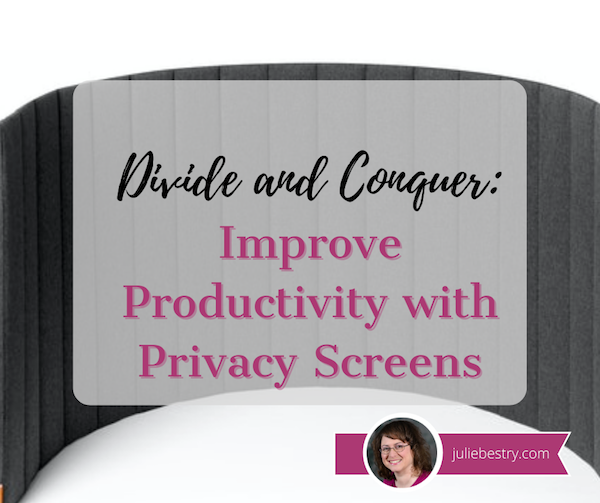
One of the most popular photos ever posted to the Paper Doll blog has been the Privacy Pop Bed Tent. Whether for a shared dorm room, children’s room, or any situation where you might want a little privacy – for sleeping, reading, meditating, or focus – a bed like this lets you place a divider between yourself and the world.
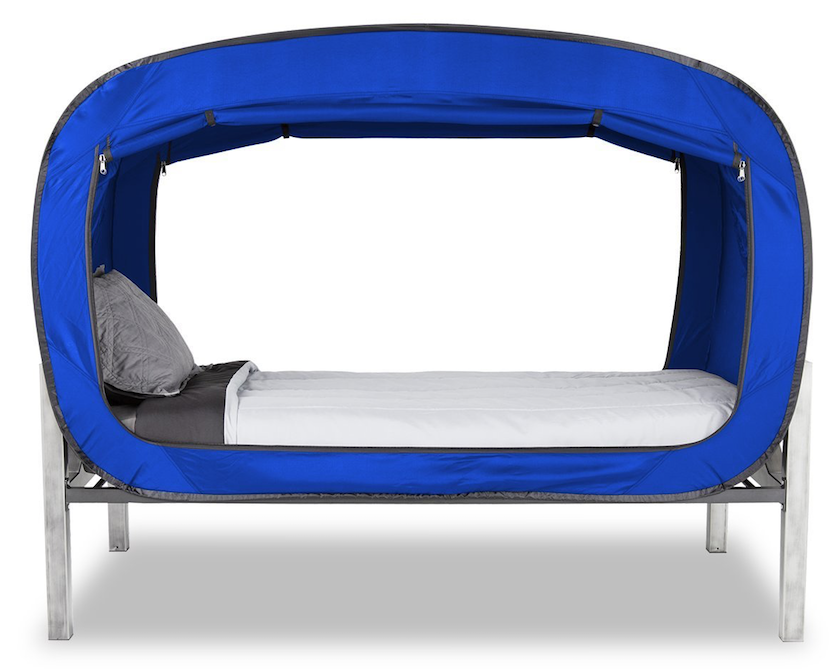
Organizing your space for privacy can yield much greater productivity.
A room or personal space divider can have the following advantages:
- Delineate a purpose for a space, motivating a stronger sense of purpose.
- Eliminate visual distractions for the user so you can maintain focus longer.
- Eliminate visual distractions for the audience during online classes, video chats, or during webinar presentations. (While virtual backgrounds can be useful, many computers are too old to run this digital solution.)
- Eliminate auditory distractions for the user.
- Dampen sounds for podcasts and audio/video production (if your dividers provide help with acoustics).
- Provide a sense of privacy from prying eyes. (If you aren’t worried about who is watching watching you, you can stay focused on your work.)
- Create a sense of ownership of one’s own space.
- Create a healthy barrier between oneself and others, particularly during flu season (and, obviously, as we are recovering from a global pandemic).
Recently, I’ve had a number of conversations with clients who are looking for better solutions for dividing their spaces.
Some have been working the better part of the pandemic from home with little to divide their own work space from that of their spouses or to divide grownup workspace from remote schooling space or play space from living space.
Others have been been struggling with a year-long, “Maaaahhhhhhhhm, she’s touching me!” lack of personal space among their kids.
Further, others are approaching a return to working in their offices and are dreading being distracted by their colleagues, anticipating having their focus, concentration, and privacy being threatened after a year of (somewhat) controlling the sensory inputs during work time.
And some are just freaked out about breathing around other people in an open workspace that, even during the best of times, ensured that they all got one another’s cold and flu germs.
Wouldn't you like to create your own private, dedicated workspace wherever you are? Share on XWouldn’t you like to create your own private, dedicated workspace wherever you are? Today, we’re going to look at a variety of options that can help you at home and work to give you more focus, a greater sense of privacy and a little more division between you and everyone else.
SET UP PERSONAL WORKSPACE DIVIDERS
The Poppin Dark Gray Portable Space Divider suits multiple circumstances where you might want a little privacy to accomplish your work:
- At desks or tables shared by multiple students (whether at home or at school)
- At a desk or table in your public or university library
- At a table in a coffee house or co-working venue
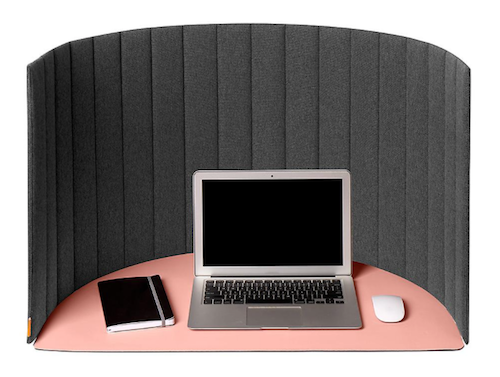
This sturdy 54″ wide by 20″ high divider unrolls and sets up to serve as a self-standing structure and says (politely), “This is my work area. All others, keep out! This means you!” letting you study, read, or work with efficiency and without distractions.
The Poppin Portable Space Divider is made of medium density fiberboard (MDF) and fabric. (MDF is an engineered wood product, manufactured by breaking down residual hardwood or softwood byproducts and turning them into wood fibres, mixing the fibers with wax and a resin to keep it bound. Then, by applying high temperature and pressure, MDF is turned into panels, which are generally more dense than plywood, so they’ll stand up sturdily.) Each of the 18 MDF panels is inserted as a slat in the dark grey fabric.
The divider is lightweight and and portable; just roll it up like a yoga mat, fasten the hook and loop closure, and carry it over your shoulder with the nylon carrying straps. No downward-facing dog required.
 The Poppin Portable Space Divider is available for $59.99 at The Container Store
The Poppin Portable Space Divider is available for $59.99 at The Container Store. (Poppin has also created Curved Desk Pads
in grey, slate blue, and blush to partner with the Portable Space Dividers. They are also available from The Container Store, for $19.99.)
If you own (or work in) an open office, you might be looking for something a little more upscale to give returning employees something to help them maintain focus. eScape Desk Screens come in a wide variety of colors (including Sky Blue, Green, Emerald Green, Orange-Yellow, Orange, Red, Purple-Red, Purple, Blue, Dark Blue, and for some versions, Silver Grey, White, and Sesame Black) and mounting styles.
The eSCAPE Edge Clamp with Knob Acoustical Desk Divider 12″ high version is made of colorful, 12 mm-thick, round-edged, acoustic tiles made from recycled plastic (PET) bottles. Five width options are available (23″, 35″, 47″, 59″ and 71″) and they are attached to desk surfaces with a knobbed clamps (two for the three smaller sizes, and three clamps for the two larger versions):
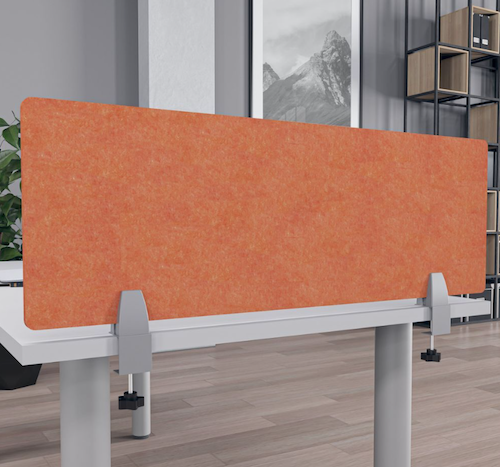
The 16″ high (shown below) and 24″ high versions offers the same colors, features, and options, but more privacy:
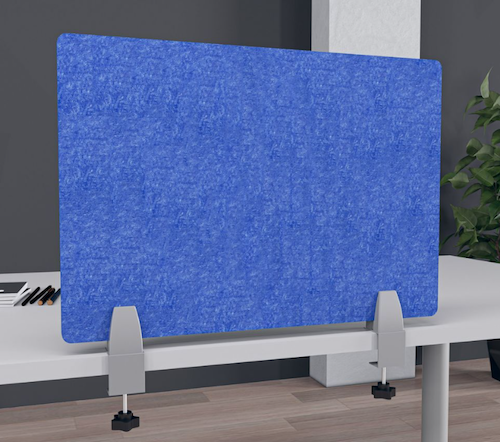 The clamped versions are sold by Skutchi for $133.39.
The clamped versions are sold by Skutchi for $133.39.
If you’d prefer a free-standing version of the eScape Desk Dividers, Skutchi also sells those.
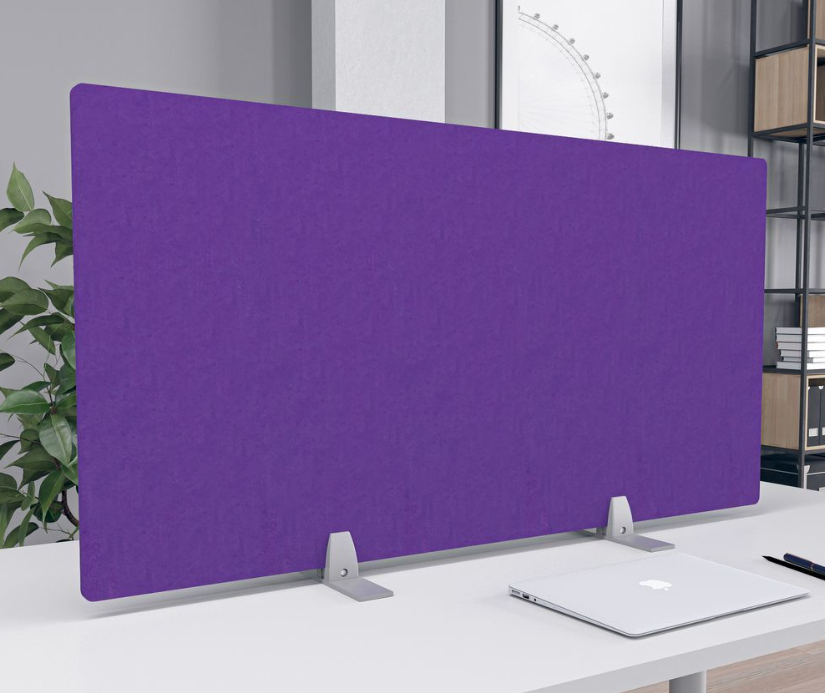
You’ll lose a quite a bit of desktop real estate to make room for the mounts, but you’ll save a bit of money, as the 12″, 18″, and 24″ high options (all with the same width, color, and feature options of the clamped versions) sell for $96.59.
Skutchi’s dividers are custom-made and available with free shipping.
Given everything that’s happened over the past year, you may be considering getting some kind of sneeze-guard to surround your work area or classroom space (for yourself, your children, or for the school in which you teach). These come at a wide variety of price points and aesthetic levels, from Applied Ergonomics’ fold-flat, polycarbonate school hygiene barriers, $299 a ten-pack:
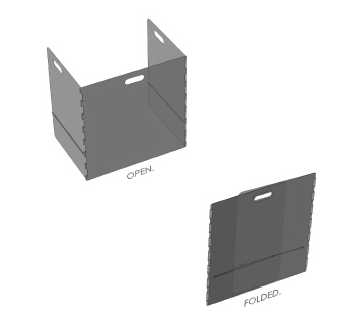
to Mergework’s Terrace and Enclave Sneeze Guard Workspace Social Distancing solutions with multiple mounting options at fancy-pants pricing.

If you’ve ever worked in an office with cubicles, you know that the absence of a door can have impact on privacy. (To be honest, so does the absence of a ceiling, but unless you move that Privacy Pop Bed Tent into your cube, I’ve got nothing for you.) If you’ll be returning cube setup, your HR department might be interested in this rolling Quartet Workstation Privacy Screen to improve productivity (and morale).

The translucent, shatterproof privacy screen measures 38″ wide by 64″ high. The frame is aluminum, while the screen itself is polycarbonate, making the unit durable and lightweight. As-is, the screen can roll into place for cublicles up to 65″ tall, and there are leg extenders included for cubicles taller than 68″.
There’s even an attached whiteboard with a nameplate so you can tell colleagues when you’ll be available and let them leave messages for you.

The Quartet Workstation Privacy Screen is available from Staples, Quill, Granger, Amazon, and Walmart. Currently, the price ranges significantly, from $261 to $390, and is the least costly at Walmart and Amazon. (There is also a sliding, non-wheeled version, measuring 36″ wide by 48″ high, which slides into cubicle walls and is not wheeled; it runs about $205.)
USE ROOM DIVIDERS TO CREATE WORK ZONES
Sometimes, you need a divider of greater size and scope. Over the years, I enjoyed being interviewed online, like the eight shows I did for Smead‘s Keeping You Organized video podcast:
Secrets to Organizing a Small Business
Fears That Keep You From Getting Organized
Paper vs. Digital Organizing (Part 1)
Paper vs. Digital Organizing (Part 2)
How to Get Organized When You Have an Extended or Chronic Illness (Part 1)
How to Get Organized When You Have an Extended or Chronic Illness (Part 2)
Essential Lists for Organized Travel (Part 1)
Essential Lists for Organized Travel (Part 2)
The problem? Behind my office is another room that is not appropriate as a professional video backdrop. Until 2019, as a stop-gap measure, whenever I made these kind of videos, I’d turn my desktop computer toward the opposite wall and move my chair; however, the overhead lighting against this background made spidery shadows above and around my head. I felt like a true Not-Ready-For-Prime-Time Player.
About eighteen months ago, when participating in Ray Sidney-Smith’s Productivity Summit 2019, I needed a better solution. My plan was to try to get a pretty room divider, something along the lines of the gorgeous Japanese shoji screens one often sees in movies — light wood, rice paper, hinged panels. Something like this, from Wayfair:
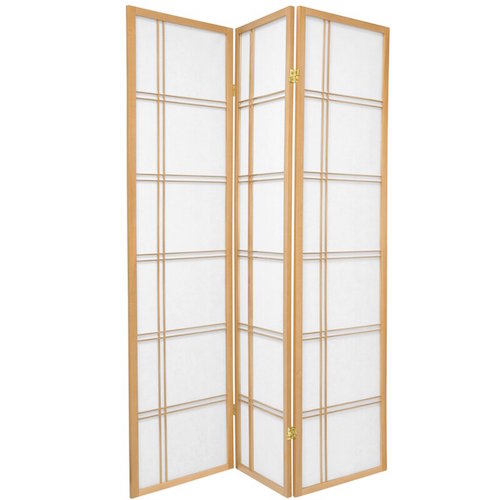
However, I was hoping for something a little less expensive than the (reasonable) $169 that this one goes for, and one available on a little speedier delivery schedule. Unable to find an appropriate screen locally, and with only a few days to go until the summit, my colleague Maria White suggested that I try Ollie’s, a factory close-out store.
There, for a decidedly more pleasing $38, I got a rattan, indoor-outdoor, hinged divider that, on video, looks far more elegant than it does up-close. If you have seen me on any recent webinars or video podcasts, you’ve seen it (and more importantly, you haven’t seen the room behind my office).
For a taste, you can peek at two recent Anything But Idle episodes I did with hosts Ray Sidney-Smith and Augusto Pinaud, focused on women experts on productivity, organizing, and technology. There’s March 8th’s where I was a solo guest panelist, as well as March 15th’s (below), where I shared the spotlight with the always-glorious, brilliant, and charming Deb Lee:
(If you make it all the way through, see if you can find where I almost devolve into a fit of giggles.)
For what it’s worth, if you do want any of a variety of hinged screens, upscale or downscale, two good shopping options are these at Wayfair and the sumptuous designs at RoomDividers.com, including their shoji screens, art prints, office partitions, and other room dividers, like this 6-foot double-sided, Lavendar Road canvas print for $149:

In researching this post, I occasionally found intriguing room dividers that do double-duty. For example, this RHF 5 1/2-foot tall, four-panel privacy screen at Amazon doubles as a corkboard message board and costs only $119.99.
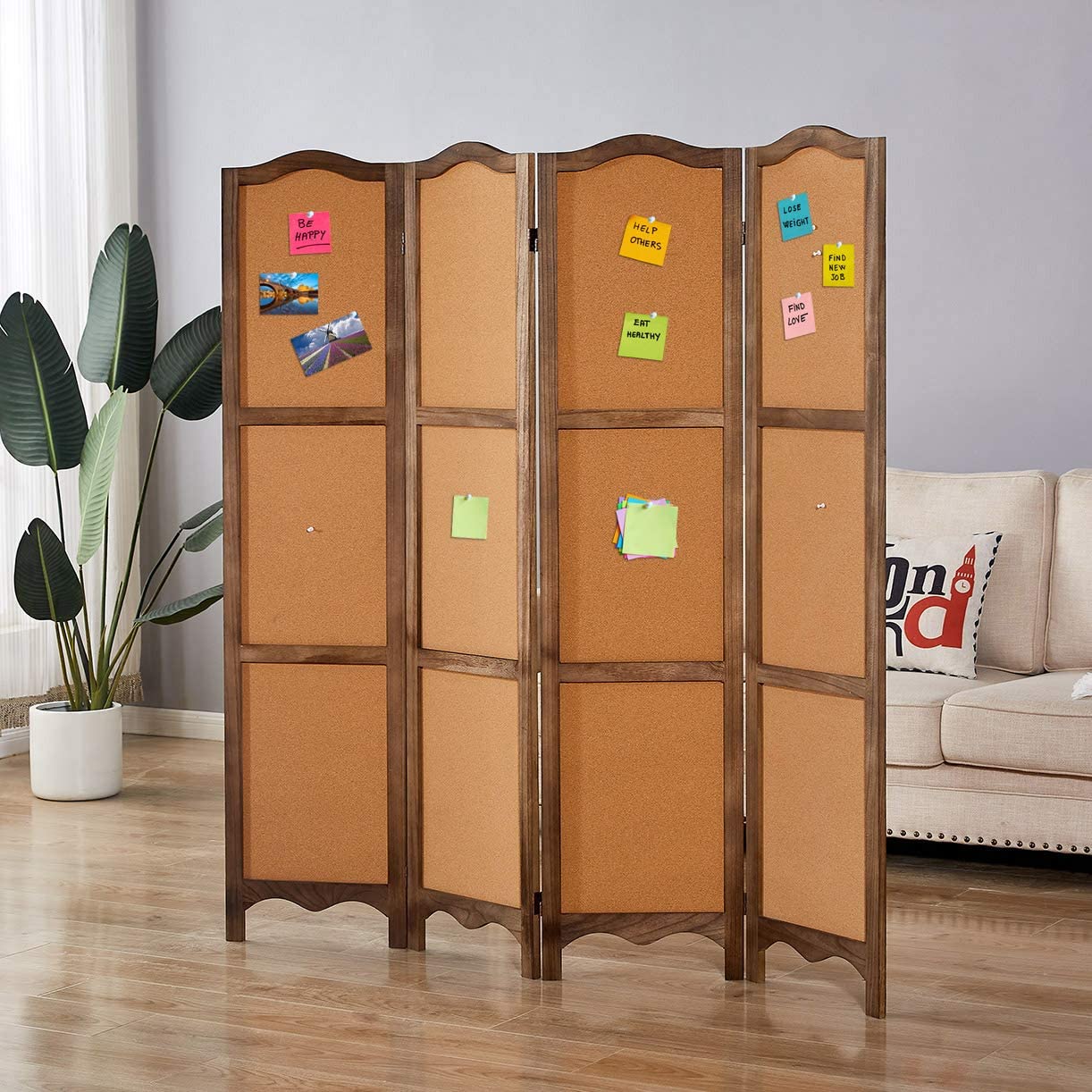
It’s not necessary to purchase special furniture simply to divide a room to provide more focus on each space’s individual purpose.
For example, if you already have a free-standing bookshelf, around five-feet tall or higher, like the Ikea Kallax shelves, you can easily divide a room into sections merely by placing the bookshelf between your two spaces, making a sleeping area and study space, or office and workout area. Check out Apartment Therapy’s The Best Bookcase Room Dividers to get some inspiration.
CONSIDER SPECIALITY DIVIDERS FOR YOUR SPECIAL NEEDS
Of course, sometimes, you will want specialized furniture.
Imagine you’re building a career as a podcaster but you’re a renter and can’t affix acoustic tiles to the wall to create an audio studio. And let’s say you don’t have a walk-in closet loaded with a wardrobe of clothes to muffle the sound. You might opt for the Versare Versipanel Flexible Sound Control Partition Wall, sold by Walmart for $819.
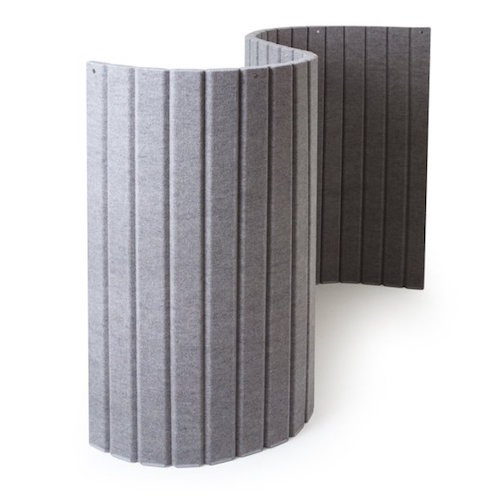
The Versipanel is designed to be an attractive, sound-absorbent, wall enhancement. It’s 8 feet wide by 6 1/2 feet high, comes in blue, black, and grey, and is one single fabric panel with flexible segments.
Rather than being positioned straight-up, like most room dividers, the panel is meant to be positioned with some curve in it in order to stand up & be stable on its own. (For a larger divider, multiple units can be connected end-to-end with the pre-installed heavy-duty magnets.)
Store the Versipanel flat against the wall, or (like a VERY LARGE yoga mat), it can be rolled up and carried away to storage.
If you offer specialized teaching services for tiny humans, whether at a child care center, private school, or tutoring service, you might have a reason to invest in a more serious set-up. Discount School Supply has a wide variety of room dividers, from their Big Screen Right Angle Panels (for $185):

to their line of Big Screen Right Angle Panels mini-classrooms (sure to muffle sounds and improve focus) for $586.87.

FIND YOUR IDEAL DIVIDER
This post is just a sample of your options for organizing by dividing your space, creating zones, giving you privacy, and eliminating distractions. It’s meant to give you a taste of the possibilities available rather than a complete resource. Depending on your physical needs, budget, and the size of your space, you may want to use the following search terms to locate the right dividers for you:
- Room Dividers
- Privacy Panels
- Modesty Panels
- Hygiene Barriers
- Anti-Microbial Barriers
- Acoustic Dividers
THE ULTIMATE IN PRIVACY
If none of these ideas provide you with the level of privacy you need, especially in the workplace, there is one option short of sealing yourself up at home and pretending you’re still on lockdown, though it may be difficult to get your company onboard with the costs.
Poppin has a line of office “phone booths” that gives you a safe, quiet office within your office. The PoppinPod Om Sit and PoppinPod Om Stand, both for $5499, are made of high-grade glass and steel, and give you the privacy to focus, make confidential telephone calls, and isolate yourself from that office mate who does that thing. (You know what it is. Let’s not spell it out.)
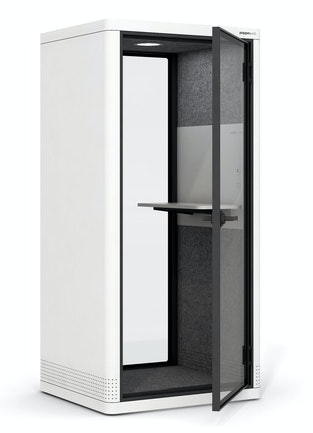
Both of the PoppinPod Om versions come in black or white, have USB chargers and a motion-activated light and fan, and feature dark grey, sound-absorbing PET lining. They’re shipped and delivered fully-assembled, because apparently the Poppin people have seen us trying to assemble Ikea furniture and don’t want to embarrass us.
For fancier workspaces, or if you’re hoping to have a work partner with you but still divide yourselves from your colleagues, the PoppinPod Kolo series upgrades from the Om experience and can accommodate 2, 4, or 6 individuals at prices ranging from $7000-$30,000.
And let’s face it, this is as close to Doctor Who‘s TARDIS as we’re ever going to get.
The Perfect Unfolding As We Work From Home
 Readers, I beg your indulgence as I wax philosophical today about folding and unfolding as we work from home. (No, this isn’t about laundry. I’ve written about that before, in 5 “Real Simple” Reasons We Don’t Get the Laundry (or Paperwork) Done.)
Readers, I beg your indulgence as I wax philosophical today about folding and unfolding as we work from home. (No, this isn’t about laundry. I’ve written about that before, in 5 “Real Simple” Reasons We Don’t Get the Laundry (or Paperwork) Done.)
This weekend was my birthday. Last year, I went out to dinner with a friend, and I remember that strange week, as everything was changing, but nobody knew what was to come. We tensely folded ourselves in toward the booth, away from our fellow diners. We were already being more circumspect, but it wasn’t until the next day or so before the reality of 2020 set in. (But this post isn’t really about that, either.)
The Folding and the Unfolding of the Lost Year
Over the past year, I’ve been thinking deeply about folding and unfolding as it relates to our lives now, both at home and at work. In most ways, our lives constricted 12 months ago. We were running around, blissfully living our lives, commuting to work, dining in restaurants, out there in the world. And then, almost overnight, we folded ourselves up, kit-and-caboodle, and took ourselves home. Crumpled into tinier lives in smaller spaces (at least smaller than the whole world we had at our disposal before), anxiety squished us into smaller versions of ourselves.
We’d packed up our work bags, our school bags, our schedules, and folded ourselves away in our houses, nervously watching newscasts and doomscrolling our devices as we perched on the edges of our couches and dining tables.
And then something interesting happened, though we couldn’t see it at first. We unfolded ourselves. We embraced freedom from sitting in one stuffy workspace, at one desk, between the same two co-workers. We unfolded the squished toes that had been crammed into the shoes we wore as part of our uniform to be taken seriously at work. We unpacked our projects and spread them out in the new spaces we had to create to work at home while avoiding feeling like we were living at work. (More on that in a bit.)
The Unfolding of New Opportunities
As some parts of our lives fell by the wayside, other new adventures eventually appeared.
I am proud to announce that I recently became Meori‘s first guest blogger. You might recall that I first wrote about Meori three years ago, in NAPO2018: Paper Doll Explores Meori & the Glorious Goodies Within.
When I was first contacted about being a guest blogger, I was enthusiastic but cautious, as I always am in these situations. As a Certified Professional Organizer®, I’ve built my practice on developing strategies to guide clients in creating systems for making their lives more organized and productive. I view organizing products as tools, always worthy of consideration, and I tell clients (and you readers) about how those tools can serve their needs. (And yes, I tell you about my favorite products.)
But I’m not a salesperson, and if they’d wanted someone to be a product spokesperson, I wouldn’t be anyone’s first choice. (I think we can agree that brevity is not the soul of my wit, and “pithy” is not in my wheelhouse.)
So, I was delighted when I first spoke with Deirdre Meyer, co-owner of Meori (with her husband Dirk) and Karen Oboy, Meori’s sales and marketing manager, about this opportunity. Deirdre made it clear that she wanted bloggers who knew about the necessary skills and systems of organizing.
And better yet, she wanted me to write a LONG post. (Readers? Can you imagine how hard it was for me not to jump through the Zoom window and hug them in their Seattle offices?)
In my premiere post, Home Office Storage Ideas: From Dad’s Office to the Modern Home Office, the great people of Meori gave me free reign to cover both the strategies (mindsets and systems) behind creating a peaceful, productivity-producing home office space and tactics (tools and methods) for making it all work. I encourage you to read the post at Meori’s site and let us know what ideas resonated with you. 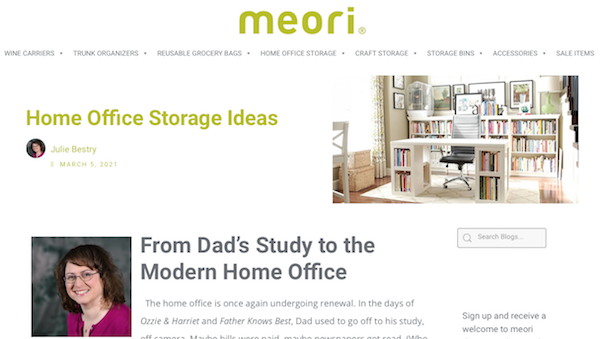
Unfolding and Folding Products
Initially, I was intrigued by Meori’s growing line of fold-flat storage products for home and office, but I was puzzled by their name, as I’d seen that the labels on the packaging were in English and German, and Meori didn’t strike me as a German word. It turns out, they combined two Japanese words, “meian” for great idea and “origami,” to create meori as “the fantastic idea of folding.”
I got excited, because I like things that fold and unfold, or collapse and recreate themselves. I’ve written before about how much I love Origami Rack shelves, desks, and racks, which “unfold” much like one opens an accordion or an ironing board. From flat-pack to fully useful in a minute!
Long before the pandemic, I was singing the praises of my Origami 6-Tier bookshelf, shown in operation above.
(I’m not an affiliate for either Meori or Origami Rack, but it occurs to me that, like Reese’s Peanut Butter Cups, these would be two great tastes that taste great together!)
Time To Unfold Again
We all eventually found our temporary footing, dealing with each ad hoc bump in the road that was 2020-2021. But lately, as the one-year mark approached, I’ve heard more complaints. Sitting on Zoom calls, I’ve noticed more and more people looking tense, almost as though they’d folded themselves directly into those tiny Zoom boxes. People are rolling their shoulders, trying to get rid of cricks in their necks. They’re fidgeting. They’re hitting the pandemic wall. They’re experiencing burnout.
Does that sound like someone you know (or someone you became) in the past year? It wouldn’t be surprising if it did, because a study by the CDC’s National Center for Health Statistics shows that 41% of Americans were showing signs of clinical depression or anxiety disorders at the start of this calendar year, up from 34% last spring. As I’ve written many times in the past year, we need to give ourselves some grace.
There have been multiple articles about hitting the pandemic wall:
It’s Not Just You: A Lot of Us Are Hitting the Pandemic Wall (Huffington Post)
Why Kids Are Hitting the Pandemic Wall (CNN)
America Has Hit the Pandemic Wall (The Washington Post)
This article from Mayo Clinic, Job Burnout: How to Spot it and Take Action, was created in the “before times” but it’s just as apt now. They define burnout as, “…a special type of work-related stress — a state of physical or emotional exhaustion that also involves a sense of reduced accomplishment and loss of personal identity.” Those symptoms sure sound familiar to my friends and clients.
Personally, after hitting a snag back in April, 2020, I felt like I was handling everything fairly well. After all, I’d been “working from home” (for administrivia) for most of twenty years, though it only make sense to organize at clients’ homes and offices, because that’s where the clutter lives!
“You are not working from home; you are at your home during a crisis trying to work.” pic.twitter.com/nsfb2ecTZZ
— Ethics in Bricks (@EthicsInBricks) January 2, 2021
But, as wise tweets reminded us, we weren’t just working from home. We were working from home during a crisis. I thought I’d handled the complexities of virtual organizing and “working from home” well until January, and then all bets were off. Focusing got harder; I blew through a soft deadline and had to explain to the nice Meori people that yes, I’d hit the pandemic wall, too.
Unfolding & Untangling Your Work Self and Your Self Self
It’s been my contention for a while that the biggest problem we experienced, just after we got a hang of working from home, is that we made our work lives so comfortable that we were now living at work.
One good thing about our old lives was that, for most people (who weren’t already working from home), it was easy to fold oneself up to fit in a work space and a home space. Before the pandemic, people who went off to work didn’t need the same kind of help as work-from-homers, such as I’d presented in R-E-S-P-E-C-T: The Organizing Secret for Working at Home back in 2015.
That post focused on how to show respect to yourself, and how to get others to respect the value of your time, when you’re working from home. Nowadays, that advice is more needed that ever.
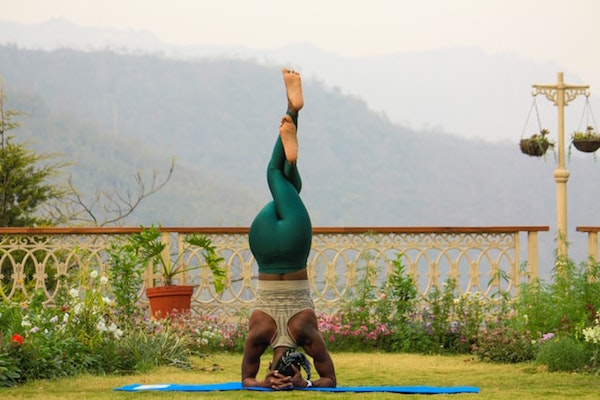
Photo by rishikesh yogpeeth on Unsplash
If you’re feeling all-folded-up, maybe even tangled up, I encourage you to start with the following:
1) Separate your work space from your home space.
I know, that sounds ridiculous. You probably don’t have oodles of space You finally found the “good” lighting so you don’t mind having your Zoom camera turned on, so I’m not going to tell you to create two spaces, one for Zooming for work and one for Zoom-hanging with your friends. (But if you do have the space, your friends will love you just as much if you move the laptop or tablet to the couch, and look more like if they were on the couch with you, in an imperfectly-lit room, and less like you’re about to advance a Powerpoint slide at any moment.)
Basically, it’s been a year, and you’ve probably got a work space that works for you. (If not, that’s even more reason to check out my Meori guest post!) But maybe it’s time to create more space at home in which to live.
As the weather warms up, maybe move a chair onto your front porch and read 10 pages of a novel in the fresh air and daylight during your lunch break? Maybe make sure you’re not eating at your desk, even if your desk is your dining table?
2) Understand that downtime is good for you – and your career.
Usually, my advice is designed to make your work life more productive. For years, in the “before times,” I told clients to treat working from home as if they were working from an office. Run laundry or make personal calls at lunchtime, if you must, I’d say, but work when you are “at work” and do home things on your “personal” time.
Wow, how very 2019 of me!
This advice made sense when the struggle was ignoring inanimate sensory inputs (a pile of laundry, bills to be paid, dinner to defrost); now, the sensory inputs are tiny humans needing help, or a gentle prodding, with online school. You can’t, and shouldn’t, be all-work-and-no-play during the day.
According to research by the National Bureau of Economic Research, Zooming is helping us keep our meetings shorter, but we’re working longer. “We also find significant and durable increases in length of the average workday (+8.2 percent, or +48.5 minutes), along with short-term increases in email activity,” they found.
As the articles on hitting the pandemic wall acknowledge, we’re all experiencing overstimulation. We’re ALWAYS ON, so of course it’s hard to wind down. Just as the temptation to address home things during work hours must be guarded against, we struggle with doing more work during “home” time.
So, maybe don’t check work email while you wait for the pasta to boil. Pick up a book from your to-be-read pile instead of a report from work. Turn off your Slack notifications at night and on the weekend.
Embrace the idea that you are more than just your job. Perhaps read this New York Times article, Remember: What You Do Is Not Who You Are. A snippet I particularly liked, in (and following) an interview with Art Markman, a professor of psychology and marketing at the University of Texas at Austin, said:
“The brain needs a little downtime,” he said. “You can’t sustain concentration. Unless you can get away from the problems you’re trying to solve in your work life, you don’t give your brain a chance to reset and come up with a different way of characterizing what you’re dealing with. So even if your primary goal in life is to be as productive as possible at work, you need some time away to make that happen.”
This doesn’t mean you shouldn’t be invested in your work or not care about your career and the people you work with. That investment can be an asset, and being passionate about one’s work can help lead to better output. Rather, give that investment a ceiling.
3) Put the commute back into your day.
Inc. Magazine recently ran an article called The German Secret to Getting More Done While Working Remotely. Even though my job is to help people be more productive, inwardly, I groaned when I read the headline. Isn’t everyone already feeling guilty and dismayed by not getting more done, as if the purpose of life was to be more productive? (Paper Doll has a secret for you. I think the purpose of life is to ENJOY YOUR LIFE. Be productive so you can have more time to do that!)
Paper Doll has a secret for you. I think the purpose of life is to ENJOY YOUR LIFE. Be productive so you can have more time to do THAT! Share on XWhat did you do on your morning commute? Did you listen to a podcast? Talk to the people who sat by you on the train? Read? Maybe your “commute” was just driving your kids to school before turning around and heading home for the rest of your day. Are you missing those things? Your afternoon commute has similarly been blown out of the water.
For years, I’d recommended to clients who had trouble starting their work days to put on their shoes, even their coats, and go outside and then come back in before sitting down to work. Whether they went to a coffee house to procure overpriced coffee, walked around the block, or just went out the garage door and came back in the front door, this helped them trigger their brains that it was time to start the work day. Whether it’s our morning commute or our kids hearing the announcements over the PA at school (they DO still do that, right?), we need rituals to start our days.
Well, this fancy-pants Harvard professor – OK, I’ll be fair, it’s possible he has perfectly quotidian pants – advises much the same, though he focuses on the end of the workday. Per Professor Ashley Willhans, the Germans have a concept called feierabend. Google Translate merely says it’s “the end of the working day,” but apparent it’s more of “a daily evening celebration marking the moment when work is switched off for the day.” (And it apparently involves beer.)
In the old days, people sometimes went from work to the gym, and then home. So maybe this means our date with Yoga With Adriene needs to come at the end of our work day, and maybe that needs to be a bit earlier? Perhaps knowing that we can’t push dinner too terribly late (either for the comfort of our family or of our digestion) means that we’ll have to truly stop work so we can change from our work loungewear into our workout loungewear and work out at a decent hour so we can eat at a decent time?
My own end-of-day ritual is calling Paper Mommy. The idea of debriefing, recapping my work day, out loud (often during a 45-minute walk outside) is just what I need to unknot, detangle, and unfold my brain, my body, and my life. What kind of “commute” could you add to the start and end of your day?
Unfolding of Hope and Confidence
In the past year, my friend and colleague, Dr. Melissa Gratias, introduced me to the concept of the Shraddha Sutra she learned in her meditation class. (You can read Melissa’s take on it in her post, Are We Broken?)
śraddhā = śrad + dhāśrad literally means “that which gives you space and holds you in place” dhā provides nourishment for you to grow śraddhā conviction; faith; trust
However, my friend’s meditation teacher explained it more conceptually as “radical trust in the perfect unfolding” of one’s life.
Whoa.
Melissa and I have been discussing this concept a lot over the last year, as we look at how our spaces, our careers, our relationships, and our very lives have been evolving. I said it in my post, The Now Normal: When the New Normal Changes Quickly, and I have been surprised by how prophetic it was. (Whoohoo, Paper Doll!)
This March is not last March. We see sunlight instead of darkness. Every day, more of our parents and grandparents and friends are able to get the vaccine. More of us have a sense of what we want our lives to be (or not be) as we come out on the other side, as we unfold ourselves into new shapes and new selves.
Perhaps this probably didn’t sound very much like an organizing and productivity post. But please remember that the purpose of organizing, at least the Paper Doll version of it, is to have more space and time to do the things you want with the people you care about.
So, I don’t know about the radical trust part, but as we move forward, I hope that you experience the perfect unfolding of your life.
Paper Doll Wraps Up, Declutters, and Updates 2020
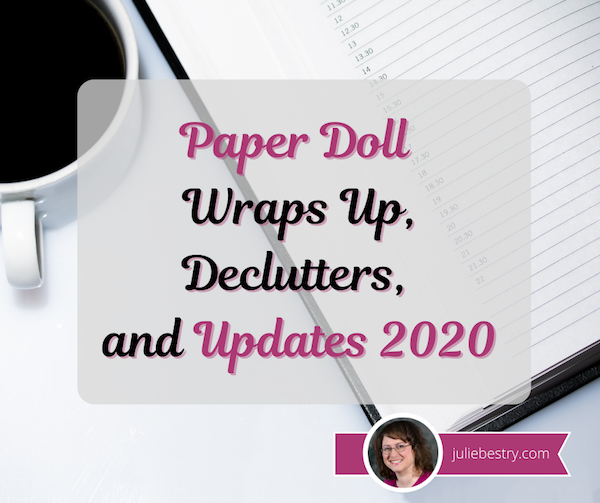
It’s been quite the year. “Unprecedented,” you might say. (Or, better yet, let’s not say. How about we purge that word from our vocabulary?) Before we turn the calendar page to 2021, there are a few additions and updates for the posts you read (or might have missed) over the past year.
PANDEMIC PRODUCTIVITY
The Now Normal: When the New Normal Changes Quickly
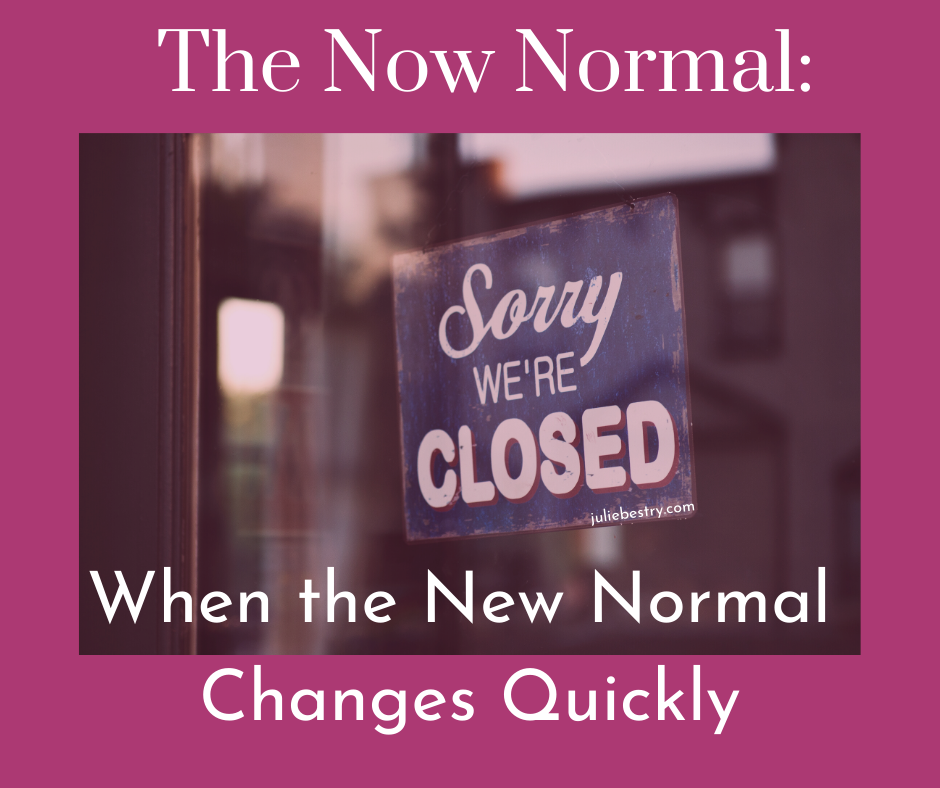
Back in March, none of us knew what the next nine months would bring. I’d acknowledged the difficulty of being at home, whether that meant working from home, home-schooling, or dealing with family and their foibles 24/7, and noted that at least, to some extent, we’d get used to it, or at least we’d have to get used to the “Now Normal” of things constantly changing and us not getting used to things. Little did we know how long (how very, very long) we’d be getting used to things constantly changing. I gave you all permission (as much as anyone needs permission from random internet bloggers) to be OK with not being OK.
Now, on the cusp of 2021, there’s light (in the form of a vaccine) at the end of this tunnel. But I suspect things will never go back to exactly where they were. Remote work had already been increasing (by 173% between 2005 and 2018); 2020 gave companies the impetus to make this a more permanent option. Companies that had believed workers could never be as productive when working remotely found that the opposite was true. According to research collated by Apollo Technical:
- Performance can improve up to 13% when working remotely (in a quieter, more convenient workspaces)
- Remote work yielded greater worker satisfaction
- Remote workers spend 15% less time avoiding work tasks
- Anecdotally, once supervisors trust the work-from-home approach and stop micromanaging, productivity increases.
This doesn’t mean we can extrapolate only good things to come out of more people working from home. Even once children and life partners are no longer in the home/work space, the distractions of household tasks (especially for women) will likely adversely impact productivity, and research indicates that productivity may take a hit due to prolonged lack of social interaction (especially for extroverts, like moi).
Some workplaces will stay 100% remote; others will return to traditional venues; and I suspect many employees will demand greater flexibility, and companies will want to consider the reduced overhead associated with smaller (or no) dedicated offices. The only thing we know for sure is that things will continue to change, and we’ll have to be nimble, accepting that the sand will keep shifting under our feet. As L.P. Hartley once wrote, “The past is a foreign country; they do things differently there.”
The only thing we know for sure is that things will continue to change...As L.P. Hartley wrote, 'The past is a foreign country; they do things differently there.' Share on XPaper Doll’s Ultimate Guide to Organizing a Virtual Field Trip

This post proved to be one of the most popular during the early pandemic. Organizing our days to include breaks, including virtual day trips to escape monotony, became a necessity this year, and rarely a week went by when a reader did not email or tweet or post to tell me about other cool virtual field trips.
Friend of the blog Janet Barclay knows that Paper Doll is a consummate Jane Austen fan, and forwarded Celebrate Jane Austen’s Birthday With a 360-Degree, Interactive Tour of Her House, and from there it was a quick hop, skip, and virtual jump to the Emma Thompson-narrated Twelve Days of Christmas special. There are also paid live virtual tours of Jane Austen’s House from Home, trails, and exhibitions. (Two live tours in January each go for £5, or about $6.78).

Discovery Education has developed a variety of live and on-demand, family-friendly interactive field trips. Each is free and includes a companion guide with hands-on learning activities! Take your kids to “visit” the Johnson Space Museum in Houston, see the cars of the future, hobnob with polar bears in the Tundra, and so much more. Whether you need a virtual field trip to break up winter vacation, quell home-schooling doldrums, or reverse just too little play time, Discover Education is a delightful addition to the options in my post.
Perhaps you binged too much of The Crown and need a reality check? Take a virtual tour of Buckingham Palace. Prefer a different venue? How about the Taj Mahal, the White House, or the Vatican?
Virtual Museums started an interactive map of the world’s museums available to virtual visitors. (Create an account to track and rate your visits.) From the Canadian Museum of Human Rights to South Korea’s National Museum of Modern and Contemporary Art to the mysterious fossils of the Graz Natural History Museum in Austria, new field trips for grownups are appearing all the time.
And if you need the the kind of field trip that takes you away from the hubbub, Escapista may be to your liking. Escapista has developed a manifesto to explain its approach to selecting opportunities for immersive meditative experiences, from pausing by a snowy river to Norway’s “Slow TV” experience of ten hours on a train. (Click the speaker icon to turn on the audio.)
Be sure to organize time in your life to relax and to learn for fun.
Does Anybody Really Know What Time It Is? 5 Strategies to Cope With Pandemic Time Dilation

There’s an irony of mentioning time dilation between two long weekends marked by Christmas and the new year. I’ve lost count of how many people have told me they checked for the mail on Friday or took the trash to the curb on the wrong day.
In the original post, I explained why our body clocks became so borked during our quarantine and recommended five strategies, with LOTS of tactical suggestions, for keeping everyone from becoming unstuck in time:
- Put structure in your life.
- Enhance novelty.
- Create vivid sensory clues for the passing of time!
- Get what you know you need! (Daylight, sleep, exercise, and for those of you who’ve had the same pair of sweats in rotation since St. Patrick’s Day, get dressed!)
- Take a technology break.
As a professional organizer and productivity coach, my job is to help people get more out of their time. But efficiency isn’t everything. In a year like we’ve had, and going forward, some daydreaming and navel-gazing preserves sanity. If you find yourself losing track of time too often, add in a bit of structure to your day and use technology to get a quick “beep-boop.” But do give yourself permission to enjoy the one small benefit of this year, living by your natural body clock.
Organize Your Health: Parental Wisdom, Innovation, and the New Time Timer® Wash

Don’t touch your face. Wear a mask. Wash your hands. It’s good advice, so listen to your mom. Listen to mine.
READING RENEWAL
12 Ways to Organize Your Life to Read More — Part 1 (When, Where, What, With Whom)
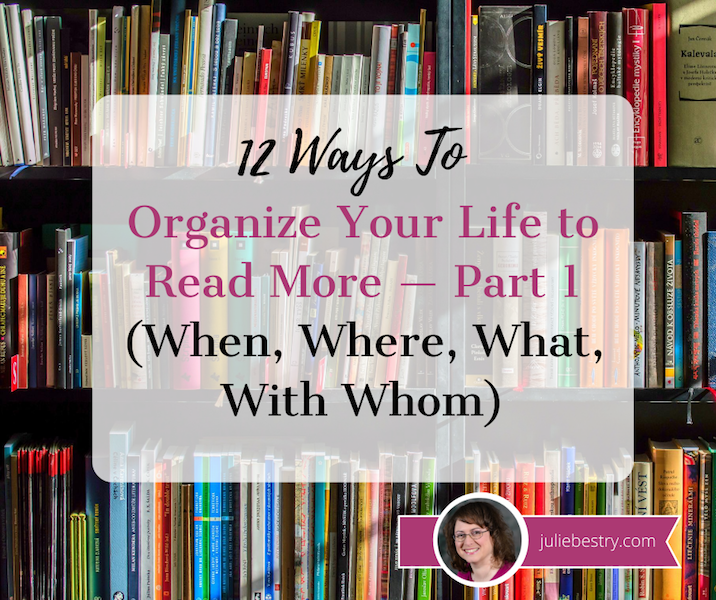
I’m not the only embracing tips for reading more. Oprah, the ultimate book club leader, may have ended her print magazine, but the December issue offered up 20 Simple Ways to Read More and Enjoy More Books in 2021. (Personally, though, I preferred my take on developing a reading nook. What do you think, readers?)
12 Ways to Organize Your Life to Read More — Part 2 (Reading Lists, Challenges & Ice Cream Samples)

Want to read more in 2021? You’ve got a bounty of options for finding recommended reading lists. One of my favorites is the NPR Book Concierge. (Find annual suggestions going back to 2013.)
If, instead of looking for a specific title, you want to find a 2021 reading challenge that, well, challenges you, opportunities abound, including:
The Uncorked Librarian (Most intriguing suggestion: read a book set on a train.)
Modern Mrs. Darcy (This year, it’s not just reading prompts, but an entire interactive kit for creating your personalized reading life!)
GirlXOXO Master List of Reading Challenges (While I’ll skip the challenge to read mysteries with cats as main characters, there are certainly lists galore for every taste!)
Meanwhile, who would be up for a Paper Doll reading challenge to embrace books on organizing and productivity?
How To Make Your Reading Time More Productive With Book Summaries
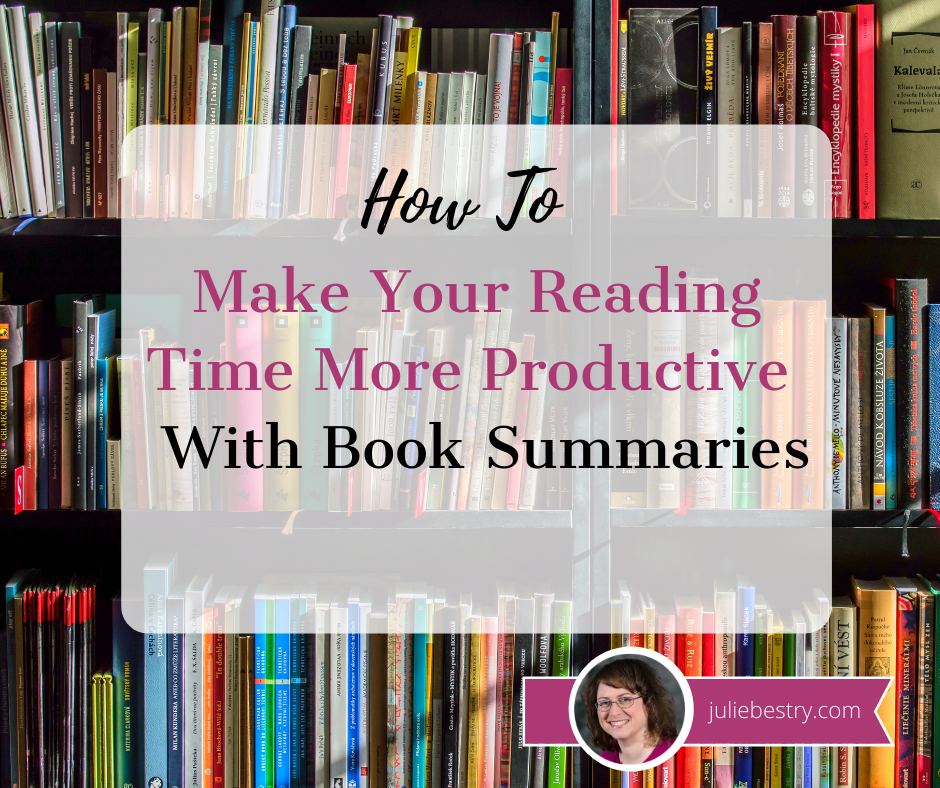
My coverage of book summaries focused on non-fiction. Unless you’re in 11th grade English class (sorry, kids), you probably don’t want summaries of novels. However, you can get ice cream tastes of fiction, to see if you like an author’s style.
- Most people are familiar with Amazon’s “Look Inside” feature, which allows you to click a link above the book cover and read a handful of pages. But did you know that many Kindle books have “Send a free sample” link so you can preview chapters? Check in the browser version, not the app, below the “purchase with one click” section and above the “add to list” button.
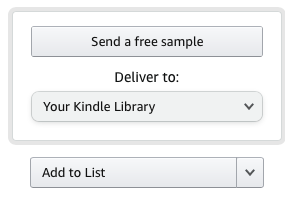
- You can also get a free audio sample. Check for a link under the book cover.

- Literary Hub has daily offerings of novel excerpts. Click on the book cover you want to try, and the resulting page provides short author bio and a selection from the novel. Titles range from new releases, like Mrs. Murakami’s Garden, to reprints of classics, like Betty Smith’s Tomorrow Will Be Better. (Literary Hub also has short stories excerpted from short story collections.)
PAPERWORK DECLUTTERED
Organize for an Accident: Don’t Crash Your Car Insurance Paperwork

In April and May, due to much of the country quarantining and people driving far fewer miles, many insurance companies offered 15%-25% premium rebates to customers.
While rebates largely disappeared by June, that doesn’t mean you should be paying full price if you’re still staying close to home. For example, if your workplace has decided to go “permanently remote,” and you no longer have a commute, it’s worth contacting your insurance agent about potentially lowing your premiums now that you are regularly driving less each week. One option insurance companies are exploring is vehicle telematics, little “black boxes” that keep track of your speed, mileage, and precision at accelerating and decelerating, and report back to the insurance company. Safer drivers get better rates.
Similarly, if your college-age student is not currently on campus and is attending school remotely (from your home), that means your car is in the driveway most of the time, not states or time zones away. Review your situation with your agent for the greatest number of discounts.
Paper Doll On Narwhals, Fake News, and How To Get A REAL ID

Everything in the post is still accurate except for the enforcement deadline. Due to COVID, the federal government delayed enforcing REAL ID by one year, to October 1, 2021. Remember, as of next October, if you don’t have Real ID-compliant identfication, you won’t be able to board a domestic flight or enter federal courthouses or restricted federal facilities, like military bases, nuclear power plants, or the White House.
Paper Doll Says The Tax Man Cometh: Organize Your Tax Forms

The forms are the same, but a few the rules have changed. Kiplinger’s Magazine covers a few dozen of the Tax Changes and Key Amounts for the 2020 Tax Year.
ORGANIZING ADVICE, PLAIN AND SIMPLE
The Truth About Celebrity Organizers, Magic Wands, and the Reality of Professional Organizing

As you head into 2021 armed with resolutions to get more organized, please review my counsel in this post. I stand by my word that there are no magic wands!
And in a future post, I’ll have more to say about advice from celebrity organizers with regard to organizing by color. Here’s a preview:

(Readers, if you like curry in your pumpkin pie, feel free to tell Jacki directly!)
Organize Away Frustration: Practice The Only Good Kind of “Intolerance”

This is the perfect week for you to take note of whatever frustrated you during the holiday season: a light system with too many broken bulbs, an artificial tree that has seen better days, a sense of obligation to send holiday cards to people who haven’t so much as liked one of your Facebook posts in a decade. Stop tolerating what doesn’t work for you, and if you don’t know the solution, seek help to find one.
Paper Doll Peeks Behind the Curtain with Superstar Coach, Author & Speaker Leslie Josel
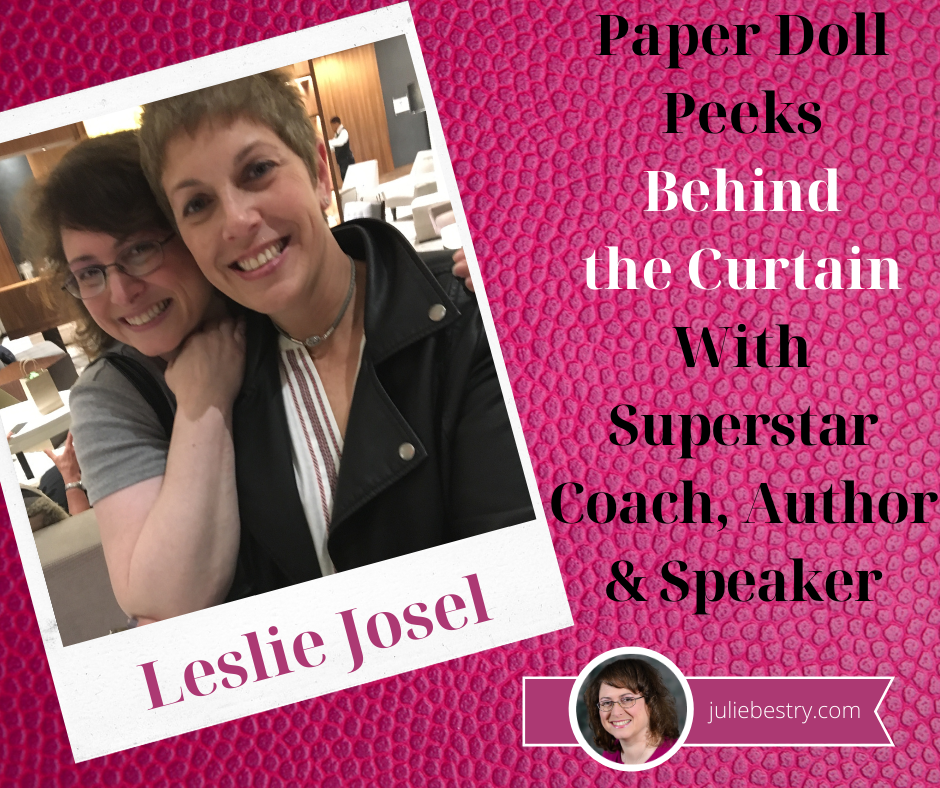
Our talk about 1980s sweaters may have been dated, but discussion of student procrastination is not. This fall was the first semester that was 100% in COVID times; even stellar students struggled, and “taking an incomplete” has become a common refrain. If you have (or are) a student, Leslie’s How To Do It Now, Because It’s Not Going Away should be on your bookshelf.
Organizing in Retrospect: A Confessional Look Back at 2020
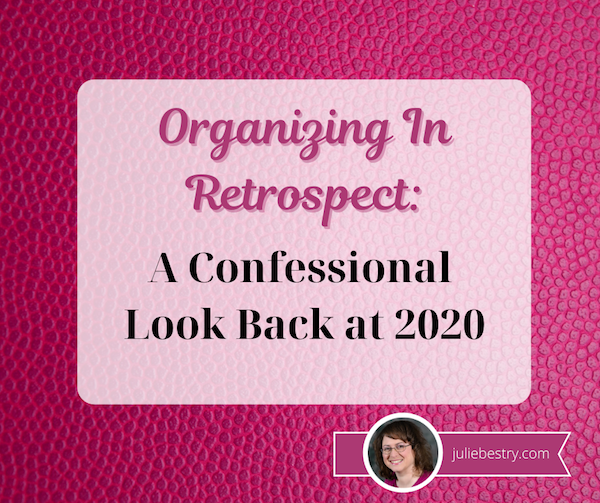
Writing this post, I realized I accomplished more than I realized. (Which would have been easy; when people asked what I’d been doing this year, I was often at a loss for words. “Missing my mom, my friends, and my travel plans, eating too much cheese, and craving Chinese food” seemed like an ineffective response.
This quiet lull before the new year is the perfect time to pull out your calendar and scan your To Do lists. Take notice of your achievements; in a year like this, it’s easy to forget small (and even not-so-small) victories. Ask your friends and loved ones to report back on the successes they recall from your year. Tally them up. Whether you use this in your next performance evaluation at work or just to buck up your self-esteem, remember that surviving this year intact is an accomplishment!
CLUTTER-FREE HOLIDAY GIFTS
In a Downton Abbey-themed post a few years ago, I told you about Give Back Box, a program whereby you could gather up the items your new holiday presents made redundant and easily ship them off to charity. This year, especially, when a touch-free donation option is especially useful, I encourage you to explore Give Back Box.
Clutter-Free Holiday Gifts for the Weird Year of 2020 (Part 1): New Twists on Old Favorites

For those of you looking for gifts of cooking classes, two highly praised options came in after deadline: King Arthur Baking‘s impressive calendar of interactive, online cooking and baking classes, and Milk Street‘s live-streamed and recorded, self-paced virtual classes. (If you give a cooking class gift to someone with whom you live, you get to eat the homework!)
Clutter-Free Holiday Gifts for the Weird Year of 2020 (Part 2): Giving Well, Giving Back

In addition to tangible gifts that give back to others, I wrote about charitable giving in your recipient’s name. Due to COVID, new tax laws let most taxpayers deduct cash donations of up to $300 made by December 31, 2020 when filing taxes in 2021 – even if you don’t itemize. (Note, this is a “per return” deduction, meaning married couples get the same $300 deduction as singletons. Consult your tax advisor.)
Clutter-Free Holiday Gifts for the Weird Year of 2020 (Part 3): Organizing Yourself & Others

Finally, I hope one of the gifts you give yourself is the time and opportunity to keep reading organizing and productivity advice here at Paper Doll.
Thank you, my dear readers, and have a happy, healthy 2021!
Does Anybody Really Know What Time It Is? 5 Strategies to Cope With Pandemic Time Dilation

Does anybody really know what time it is? (I don’t)
Does anybody really care? (care about time)
If so I can’t imagine why (no, no)
Chicago, Chicago Transit Authority, 1969
©Warner Chappell Music, Inc, Spirit Music Group
This is not a post about time management.
In full disclosure, I started writing this post in February for Time Management Month. Paper Doll strongly believes that we cannot manage time; we can only manage ourselves. But we do need to better understand time, to have a sense of how it passes. And for most of us nowadays, it’s passing…well…weirdly.
We don’t know what time it is. We don’t know what day it is.
I don’t know who needs to hear this, but today is Friday.
— Laura Marie (@lmegordon) March 21, 2020
Just asked my husband what day it is. He’s Googling it. I’ll get back to you all with the results.
— Elizabeth Hackett (@LizHackett) April 8, 2020
Alexa is getting tired of me asking what day it is.
— Rodney Lacroix (@RodLacroix) April 17, 2020
In case you were worried that it was just you, even the news media has been talking about it.
Once we settled into sheltering-in-place, many of us, especially those working from home, found it speeding by as we added work-from-home tasks, family tasks, and self-education tasks. We sought anything we could to stop April from feeling like the sluggish month of March. And what does May hold?
Why We’re Losing Track of Time
It’s not that strange that we’ve lost our sense of time. Think about the week between Christmas and New Year’s, where every day feels vaguely like Sunday. We’re not working, or if we are, there’s a strange hum of quietude. Is Grey’s Anatomy on tonight? Is it Trash Day?
Vacation days are like this, too. For the first day or so, we’re on “real” time, not only hyper-aware of what day it is, but when it’s 10:30a, even if we’re on a beach or in a museum, our internal clocks tell us that our colleagues are stepping away to the break room or the coffee truck. Vacationing parents may be dressing for a late romantic dinner out but be subtly aware that normally, they’d be corralling the tiny humans for bath-time.
But by a few days into the vacation? All of that gets swept away. When I went to Italy in 2018, I realized that by the time we left Rome, it was no longer Friday, but merely “Day 7.” My real life was a hazy memory.
We’ve Lost Our Sense of Routine.
There are no daily markers. We’re not going to work on weekdays or having our Monday stand-up meetings. We’re not attending religious services on weekends, and we’re not driving our kids to piano lessons on Wednesday or soccer practice on Thursdays. We’re not going to yoga. We’re not going anywhere!
We are used to marking time by space – weekdays mean work or school; weekends mean stores or attending religious services or restaurants with friends. Now, our dining rooms are schoolrooms; our kitchens are offices. Our living rooms become gyms. We’re in the same few rooms doing everything. Our surroundings aren’t changing even when our activities do, so even if we’re substituting virtual activities for the “real” ones, everything has an otherworldly, dreamy quality.
Further, we’re not doing any of the little things that mark the time advancing in smaller increments (minutes, hours) toward the bigger events. If we’re not getting up to go to work or school in the morning, there’s no reason not to read until the wee hours. If the kids aren’t going to school, there’s no rush to finish dinner and clean up the kitchen we can pack their lunches for the next day.
There’s a sameness to our days. There’s no ebb and flow to our hours. We’re moving through molasses and then we’re our own time-lapse videos.
We’re Busy, But We’re Not Being Satisfied
As a professional organizer, I split my time between working in clients’ homes and offices, usually in four-hour blocks, helping them achieve their organizing and productivity goals, and working in my office on the administrivia of small business: researching and writing blogs, providing organizing advice to media outlets (speaking of which, check out page 58 of the May 2020 issue of Real Simple), talking to prospective clients, marketing, bookkeeping, and so on.
Although some clients are opting to avail themselves of my services virtually, my workdays are now spent primarily in the 8-foot square box of my office. I’ve done enough webinars and classes, including Yale’s The Science of Well-Being, that I’m probably only a few webinars away from getting a pandemic diploma. I’m busy, but I don’t feel productive.
If you’re doing the work-from-home thing, you still have emails and phone calls and Zoom meetings to replace your “real” life, but deadlines are more amorphous. You may be actually getting more work done because you’re not getting distracted by Katie’s birthday cake in the break room or back-to-back meetings or getting cornered by Doug, who wants to talk about the cute thing his cat did.
But even if you’re busier (heck, even if you’re more productive), nothing has the same sense of immediacy, and sometimes that means we lose that sense of satisfaction what we’d otherwise get from having made it through Hump Day or having finally reached the weekend.
When There’s No Difference Between Tuesday and Saturday, Why Do Anything Now?
The Dowager Countess of Grantham has a point. What is a weekend anymore?
Why scramble to finish a project by Thursday afternoon if nobody will see it until Friday morning? Or Monday? Or May 73rd? Why focus your time and energy to complete your work by 5 o’clock if there’s nothing to separate from 2 o’clock in the afternoon from 9 o’clock at night?
Why? You know the answer…from the before-times. You know that it takes until about Martin Luther King, Jr. Day to feel like you’re back in the rhythm after a winter holiday break. Most of us have been sheltering-in-place six or more weeks. We need to have an accurate sense of time to be productive (whatever that means to you) both now, and later, when life returns to normalcy. We need to keep ourselves and our kids from becoming temporally feral, wildly eating and sleeping (or not sleeping), starting projects without finishing them, and generally feeling unmoored.
Allostatic Load and Lack of Novelty, or What the Heck Happened to Our Brains?
Our brains are getting mushy. In ‘Allostatic Load’ Is the Psychological Reason for Our Pandemic Brain Fog, the research indicates that our body’s physiological reactions to emotional stress can be powerful. Even though we’re sitting around not doing much of anything, our stress hormones are building up, exhausting our bodies. But we need physical energy to do mental labor, which (in addition to the emotional stress we’re already carrying) means that our brains are slowing down while we shelter-in-place.
Additionally, our brains are hungry for novelty. Every day looks and feels very much like every other, so when we’re not seeing new people, visiting new locations, or engaging in novel activities, our brains go on autopilot. We stop noticing details, so we stop making new or vivid memories, so everything blends together. Tuesday is Saturday is Everyday.
Our Body Clocks Are Borked
This isn’t all just psychological. There are physical reasons why we’re not sensing the passage of time the way we ought.
- We’re not sleeping normally. The weirdness of our schedules makes it tempting to stay up reading, or binge-watching, or gaming, and also makes it more acceptable to sleep later, getting us out of our normal habits. When we’re not going to bed or getting up at our normal times, it messes up our circadian rhythms and it distorts how short or long (or interminably long) any given day feels. If you sleep until lunchtime, it feels like it got dark awfully early. If stress-monsters woke you at 5 a.m., then by mid-afternoon, it feels like bedtime should be approaching. And because sheltering-in-place while we’re not getting a lot of new stimuli coincides with anxiety, we’re having weird dreams.
- We’re not sleeping, period. It would be weird to not be anxious right now. We’re worried about our health, and the health of our loved ones. We’re worried about our personal finances—Will unemployment benefits will ever kick in? Or if we’re still working, will our companies survive with everyone intact? — and the global economy. (Whatever you do, don’t check your 401k or IRA statements!)
- We’re not eating normally. OK, some of you are cooking Alison Roman recipes and making sourdough, and still setting the table, but most of us are grazing and not eating normal foods (or amounts) at what could only charitably be called “mealtimes.”
- We’re not getting fresh air. One of my colleagues lives in New York City and hasn’t been out of her apartment – not her building, but her actual apartment – in more than 45 days. She has no balcony, no roof access, and she’s avoiding her beloved, coughing doorman. Those of us with porches or backyards may be getting out more, but the weather around the country has been unpredictable. There were snowstorms in April. We’ve had tornados in Tennessee. And there’s pollen. So Much Pollen!
- We’re not getting sunlight. If we’re not getting outside, unless we have skylights or floor-to-ceiling windows, we’re just not getting a lot of the goodness provided by that big, yellow ball in the sky that helps us regulate our circadian rhythms and our moods.
- We’re overexposed to blue light. We’re Zooming and WebExing, in front of our computers all day without the break-room parties and water cooler convos that get us away from our screens. We’re texting with friends and reading Coronavirus news, binge-watching Amazon Prime and Netflix and Hulu. And some of you are gaming or playing Animal Crossing. All that blue light is wreaking havoc on our circadian rhythms, along with all the other things it’s doing to our eyes, or mental health, and our hormones.
5 Tips to Reconnect to Time
1) Put structure in your life.
Create the kinds of daily rituals that you wouldn’t bother with if this were a staycation. Have mealtimes at set hours. Living like we did before, where lunch came at 12:30 p.m. and dinner at 7 p.m. makes it less likely that we will graze our way to the Pandemic 15, but it will also put some definition in each day.
Develop buffer habits. If you can safely go for a walk before dinner, knowing you’ll do that between work and cooking gives you a “commute” of sorts. Listen to the podcast you’d normally dial up, or get back in the habit of calling your mom “on the way home” from work.
Time block to create boundaries in your day. I know I said this wasn’t a time management post, but time-blocking is a key strategy from the world of productivity. Block off specific times in your schedule for overarching categories: passive work projects, creative/active work projects, self-care, self-education, entertainment. A place for everything – in a schedule where everything has a place.
Even if your life doesn’t have any natural boundaries, you can create them to work as transition periods. Have one or two things on your schedule every day where you are honoring obligations to others so that you’ll wind up one task so you can show up for the next. Meet a colleague for a Zoom lunch. Hold an accountability call with a friend to help you both manage to shower and dress well before the day is half over!
Consider creating daily time blocks in which you work on a particular project most weekdays:
- 45 minutes of housework (laundry, cleaning, organizing, etc.) early in the day for a sense of accomplishment
- an hour and a half of working on your taxes (because the delayed due date of July 15th will be here faster than we expect)
- two hours of researching blog posts or sourcing graphics or planning meals
- a one-hour block, daily, of calling or video-chatting with someone
Micro-block your time with the Pomodoro Technique to conquer your tasks list. In case you’re not familiar with the Pomodoro Technique, it’s a time management system designed to battle procrastination and increase productivity. The very basic concepts? Identify what you want to work on, set aside 25 minutes to do so, and then do it – and that time in inviolable. If you let yourself get interrupted, you have to start over. Every 25 minutes, you get a five-minute break. Lather, rinse, repeat.
We’ve talked about doing pomodoros on the blog before, but for a more robust look at this incredibly effective method, my colleague Stacey Harmon has created a How to Focus in Uncertain Times Using the Pomodoro Technique® training, which she has made available at no charge.
Theme your days. Handle financial tasks on Monday Mondays. Solve problems on Weirdness Wednesday. It doesn’t just have to be activities. Celebrate Taco Tuesdays and have a meal you’re looking forward to eating…and even making.
2) Enhance novelty.
Go through your address book, your contact list, and our LinkedIn contacts. When you’re bored, or weary, instead of texting your BFF or your mother, with whom you’ve already spoken 43 gazillion times, pick two new people to contact each day.
Touch base with a professional contact and you never know what brainstorms may occur. Chat with an old friend just to find out what’s happening. Novelty can make each day more vivid and distinct from the day before.
Use different spaces. Do you have a guest room you hardly ever use for anything except piling up things that don’t have a home? Consider pushing the bed to the side to create floor space and do your workout routine there.
Is the idea of a guest room laughable?
ah yes the hotel-like guest room with a sea view that we definitely all have pic.twitter.com/8teYONwJuj
— Current Affairs (@curaffairs) April 27, 2020
Search your home for an underused space, maybe with the help of a tiny human. (They have a natural gift for such treasure hunts). As a toddler, I used to like to sit on the small steps from the kitchen down to our side to wait for my sister to return from school. In my current home, I’ve found that sitting and reading at the landing at the top of my stairs gives me good light and a feeling that my reading nook is a special place. Find a new space for an old task. Play cards in the laundry room. Picnic in the backyard.
3) Create vivid sensory clues for the passing of time!
The timer on my Fitbit buzzes at fifty minutes past the hour, reminding me to take 250 steps. Use that as your cue not only to walk, but to take your eyes off the screen. Fitbit’s reminder to move is built into the app, and most fitness trackers have a similar function. You can also try a movement reminder app like StandUp! to prompt you to take a break at a predictable time.
Whether you are bored or absorbed in an activity, a vibrating reminder that another hour has passed can help you acclimate. Similarly, you can set chimes or alerts on your phone to play hourly at 17 minutes past the hour, or set auditory alarms for every three hours, to remind you to take meal and longer activity breaks.
Go Analog. Digital clocks don’t give you the same sense of the passage of time as old-school watches and clocks. Start by looking to see which of your digital clocks you can change to an analog appearance. Android phones allow you to change your lock screen from digital to analog easily. On the iPhone, the clock app icon is a working analog clock, but the lock screen stays digital. There are apps like FaceClock Analogue to give you a working clock, but they can’t be added to the lock screen.
If you have a digital screen (like the kind for a rear-facing camera), your car will also probably let you change from a digital to analog clock.
Put a clock in places where you tend to lose track of time. Do you dawdle in the shower or while putting on makeup? Attach a small waterproof clock to your bathroom mirror with a suction cup to keep tabs on how long you’ve been debating cutting your own bangs. (Don’t do it. Just. Don’t.)

Embrace Time Timer – One of the favorite time management tools of professional organizers is Time Timer. I’ve written about many updates to Time Timer over the years, but the key thing to know is that the sweep of red helps your brain recognize time as it passes.

Please note, per Heather Rogers, the Co-President of Time Timer, “Until this crisis is over, the Time Timer apps for iOS and Android (available on the App Store and Google Play) will be free for everyone to help create some comforting structure wherever you are.
Also, all products at timetimer.com are 20% off with code HOME2020 and all US shipping is free while schools are closed.”
Of course, if analog isn’t retro enough for you, you could always take the sands-through-the-hourglass route.
Like sands through the hourglass, so are the days of our lives. Share on XYou won’t know what time it is, but if you take a few breaks to watch the time pass through a beautiful hourglass, you (and your kids) will have a stronger sense of how long five minutes or five hours really lasts.

4) Get what you know you need! The first month or six weeks of sheltering-in-place, we could be excused from letting everything devolve into an extended summer vacation, but now it’s time to get serious.
Get daylight. If you can get out and walk in nature (or your neighborhood) without encountering another unmasked human being within six feet, go for it. If you’re using the Pomodoro Technique, use your five-minute breaks to go outside. Jump rope or play hopscotch in the driveway. Run around the backyard. Dance to Lizzo on your balcony.
Get sleep. Close friends know that it’s ironic for me to give this advice, as sleep and I have a bitter and lifelong enmity. But the internet is chockfull of advice for getting enough sleep, even (and especially) if pandemic anxiety is keeping you awake.
Get exercise. Jumping to conclusions and stress-pacing aren’t enough. There are literally hundreds, perhaps thousands, of online workout options, from free to OMG-I-Can’t-Believe-I’m-Paying-Peleton. The standard go-to these days is Yoga With Adriene, but there are dozens of free live-streaming exercise classes (as well as recorded videos) to help you keep in shape. Or just run around with your kids or your dog.
Get dressed. Seriously. I know the jammies are comfy, but even having day-PJs and night-PJs isn’t enough. You don’t have to put on shoes, but if you shower, groom yourself, and actually put on underwear and real clothes each morning and change for bed each night, your sense of time will improve.
5) Take a Technology Break – There are all sorts of ways to get some social distance from your devices.
Give yourself a tech timeout every time you realize you’ve lost an hour to social media or cable news. (That’s where the fitness tracker reminders come in!) Leave the devices in a separate room during mealtimes. Talk to the people in lockdown with you, or if you’re alone (or just don’t like your peeps all that much after six weeks in the same house), read a book.
Put yourself and your family on a tech curfew. There’s nothing that happens after 8 p.m. (or 11 p.m., or whenever you’ve set the curfew) that you can’t catch up on the next morning. Give you eyes a break from the blue light.
Consider taking a Tech Shabbat. In 24/6: The Power of Unplugging One Day A Week, Tiffany Schlain makes an excellent case for the physical, mental, and social benefits of stepping away from the technology for a whole day.
Does anybody really know what time it is? Paper Doll really cares.
Paper Doll’s Ultimate Guide to Organizing a Virtual Field Trip
 Do you remember the field trips you went on as a kid? Even if the trip was headed somewhere you’d been before, or someplace that wasn’t that exciting, there was something compelling about having to turn in that golden ticket of a permission slip, having a shortened class schedule, getting on a bus, perhaps having to hold hands or hold onto a rope, and getting shushed by the teacher in a brand-new environment.
Do you remember the field trips you went on as a kid? Even if the trip was headed somewhere you’d been before, or someplace that wasn’t that exciting, there was something compelling about having to turn in that golden ticket of a permission slip, having a shortened class schedule, getting on a bus, perhaps having to hold hands or hold onto a rope, and getting shushed by the teacher in a brand-new environment.
Growing up in Buffalo, I visited Tifft Farm Nature Preserve and learned how maple syrup was tapped, how maple sugar candy was made, and never to drink a beverage if your field trip is anywhere with outhouses instead of bathrooms!
As a kindergartner, I visited the Mirrored Room at the Albright-Knox Art Gallery, and was transfixed by the mirrored walls, ceiling, and furniture, although the mirrored floor terrified me. Would I fall through into another world?
Throughout elementary school, I got to visit the planetarium built right into one of the district’s newest high schools (giving me an unrealistic expectation of high school fun). And on multiple visits to the Buffalo Museum of Science, I was shocked to come face-to-face with a wooly mammoth.
Yes, my sandwich was always soggy by lunchtime, and my feet were usually tired by the time the bus returned to school, but the whole experience gave kids a burst of energy during long stretches of weeks without holidays.
Couldn’t you use a field trip right about now?
Every day, another thousand blogs tell you how to effectively work from home, entertain and education your children, and be productive on a myriad list of home projects, all during the uncertainties of sheltering in place. And certainly, Paper Doll has thoughts on all of those things. But that’s not what today’s post is about. Because you need a break. (OK, I need a break. Even professional organizers lose their motivation in these wooly mammoth times.)
While you may not be able to take a drive downtown or hop on a subway, you can still ease your mind and stir your soul. You may not be able to pop out to the library, but you can borrow ebooks from your public library. You may not be able to attend a workshop, but there are TedTalks galore. But there’s nothing like the energy of going on a field trip…so off we go!
ORGANIZE FOR A VIRTUAL FIELD TRIP
It’s far too easy to click on some links, making your experiences every bit as quotidian as clicking over to Instagram or going down a rabbit hole of YouTube videos. To make your field trip a mental, emotional, and visceral experience that feels like an adventure, follow these steps.
1) Make a production out of it. Get dressed up. Go outside, walk around the driveway, and come back in with fresh eyes. If your kids don’t have a lot of experience with museums, you can talk about how (when we go on real field trips), we don’t run, how we talk in hushed tones, and how we don’t push people, but we will be rewarded with magical experiences in huge rooms and bright colors and cool sites.
No tiny humans? You and your partner could dress in your fanciest clothes (or, y’know, not the same sweats you’ve been wearing all week) and agree to make the trip as vivid and special as possible. No stopping to check Twitter, no doing laundry.
On your own? Make it less of a solo excursion by sharing the experience with friends. Post a photo collage of yourself, your lunch (of which, more later), and the home screen of your visit’s location. “I’m going to the Louvre today. Ask Me Anything!” Periodically, post something surprising that you’ve learned. Even if you’re alone, you don’t have to be lonely on your field trip.
Even if you're alone, you don't have to be lonely on your field trip. Share on XMake time for your trip. Don’t just sandwich a quick whirl through the web between working on your sourdough starter and bingeing the next episode of Kitten Prince. (OK, I know, but I’m not giving that show any more press!)
Build it into the homeschool day, or schedule it for after dinner on a work-from-home Zoom-filled workday. Experiences are far more memorable than tangible things, which is why they make better gifts than things that turn into clutter. Give yourself a gift of the field trip experience.
Pack a lunch. Remember the brown paper sack lunches for field trips? Paper Mommy was always a room mother, helping corral the kids, but she tucked a note and a little doodled self-portrait into my lunch, folded in with my napkin, nonetheless. Perhaps you could tuck a little quiz or puzzle into a bagged lunch for your kids (or partner, or housemate)?

Or do the museum café thing and try to make a fancy coffee. Break out some wine and quarantine cheese, and make a night of it. When I toured the UK last September, we had gorgeous weather in Scotland, Wales, and most of England, but our only full day in London was dark and rainy all morning, and plagued with kerfuffles. Once we got to the British Museum, we were feeling a bit overwhelmed; there was too much to see in the few hours we had, and we were damp and cranky. After an hour of trying to hit the guidebook highlights (including the actual Rosetta Stone!), we stopped at one of the pop-up cafés on an upper floor, and surrounded by art, had little cakes and beverages, which refreshed our bodies and gave us verve.
You’ve been locked in for perhaps a month. Take your verve where you can get it!
Do some research. Learn things before you set off for about what you’re about to see, and wrap up with investigating more about what you’ve just experienced. If you were in school, your teacher would prepare a unit in art or Social Studies (do they still call it that?) or science so you’d know a bit before the big day.
Heading to a National Park, if only in your mind? Find out how Teddy Roosevelt helped to create the National Parks System, or sign your tiny human up to be a Junior Ranger. Going to a Van Gogh exhibit? Watch the (whole) Doctor Who episode, Vincent and the Doctor. (Grab tissues.)
Ask some questions and share your thoughts. What did you like best? What surprised you?
When I was small, Paper Mommy taught me a game where we looked at each painting in which a person or animal appeared, and we narrated what they were thinking or feeling. In general, we were snarky, but I’ve now played this game in every museum or art gallery I’ve ever visited, from Chattanooga to Chicago, from Cannes to London to Florence, making up a cinematic backstory for every “character” or scene played out in grand paintings and sculptures.

(What do you think he’s thinking?)
Visiting sea or land creatures on your virtual visit? Talk to your kids about what you learn, and ask them to compare or contrast aspects of how the animals care for their young or live with their families to the way humans do it. With a fellow grownup? Discuss aspects of animal life you wish more humans embraced. Or, y’know, talk to one another in faux animal voices. You do you, boo!
Thinking and wondering, rather than just looking, makes your field trip (and the things you saw on it) much more vivid.
Make a plan for a real field trip in the future. Quarantine will end. Someday, we will be traveling again, visiting again, vacationing again. Use what you learn on your field trips to make some proactive, mindful plans to help you hold on to your vision of the future.
Visit the gift shop. No field trip is complete without looking through the tchotchkes being sold. Some places, like the MOMA, have gift shops that rival Amazon for the amazing things you can acquire. But by visiting virtually, there’s no pressure to quickly decide between making a purchase or missing out. (And most museum shops, like the Musée Dorsay store, has temporarily suspended shipping orders, anyway.) Bookmark the product page, and you can always return to buy 24/7 if there’s something that captivates you days or weeks after your field trip.
The rest of this post is designed to give you a whole host of thrilling options for your field trips, but please feel welcome to share your own favorites in the comments. Where have you visited? Where will you go?
EXPERIENCE THE WORLD’S NATURAL BEAUTY
One of the most exciting ways to travel while sheltering in place is via one one particular new exhibit and interactive documentary from the increasingly cool Google Arts & Culture project. It was launched this spring to celebrate the Centennial of the National Parks Service. (Thanks, Teddy!)
These are no mere coffee table book photos. You can take 360° tours of U.S. National Parks. You probably know a little (or a lot) about the big ones, like the Grand Canyon (yes, even if all you remember is what you saw that Brady Bunch episode!) or Yosemite.
But this exhibit concentrates on the parks you might know less about, like Alaska’s Kenai Fjords, New Mexico’s Carlsbad Caverns, Florida’s Dry Tortugas (which sounds like a food truck menu item), Utah’s Bryce Canyon, and Hawaii’s volcanoes.
Of course, once you start searching for virtual field trip options in the world of nature, the opportunities seem boundless. Consider the Nature Conservancy of Oklahoma‘s OK360° guided tours and hikes.
Wish you could commune with nature? Take a virtual dive with the National Marine Sanctuaries and visit some watery depths from American Samoa to the Florida Keys to the Olympic Coast. Virtual dives let you see an underwater habitat (and even some sunken treasures) using only your computer, phone, or virtual reality headset.
Be cure to check out nature-oriented livestreams, too, like:
The Cincinnati Zoo and Botanical Garden, where you can visit with Fiona, the baby hippopotamus.
The Georgia Aquarium’s African Penguin webcam; you can also visit the tuxedoed birds’ neighbors via the beluga whale, alligator crossing, and piranha webcams!
The world-famous San Diego Zoo’s webcams — apes, baboons, burrowing owls, condors, elephants, pandas, polar bears, tigers, butterflies…take your pick, but right now, I’m sticking with their koala cam!
The New England Aquarium’s virtual visits follows along as the penguins are fed or the giant ocean tank is cleaned, and there’s a YouTube playlist of all of the NEAQ’s virtual visits.
Canada’s Farm Food 360° offers eleven virtual tours, from dairy cow and egg farms, to sheep and pig farms, to grain farms and feed mills. Sometimes, nature isn’t just there to be seen, but to help sustain us as well.
And if the natural world of days gone by is more your field trip style, take a jaunt through the online exhibits of the Smithsonian’s National Museum of Natural History. Perhaps you’ll feel less like a dusty fossil after a panoramic view of some old bones (and butterflies, and gems, and ancient history).
TAKE A VISIT TO THE ART MUSEUM
Not really an outdoorsy person or an animal lover? (Paper Doll feels your pain.) You can focus your mind with art!
Start with Google Arts and Culture’s Uffizzi Galleries, where you get the Google “street view” of Florence, Italy’s most famous art gallery. (I visited the Uffizzi in 2018; it’s breathtaking, in terms of both the art and the views of the city through upper floor windows, but I’m sure this virtual visit is less exhausting.)
Not all tours need to be 360° visits. Sometimes, you want to see things up-close and personal. Paris Musées, a group of 14 Paris museums, including Maison de Balzac, Petit Palais, and Maison de Victor Hugo, have made high-resolution digital copies of 100,000 artworks freely available to the public on their collections website. Look at everything (making a daily lunchtime field trip) or stare at one work, transfixed, like Cameron at the Chicago Art Museum in Ferris Bueller’s Day Off. (While you’re at it, read what filmmaker John Hughes had to say about those scenes!)
Weren’t we talking about Van Gogh a little while ago? Amsterdam’s Van Gogh Museum, which houses the largest collection of the tortured Post-Impressist master, has put nearly one thousand of his paintings and drawings online and developed a Van Gogh At Home teaching program to help parents share art with their children.
So even if you feel like you haven’t been out of your house in 132 years, you can snuggle under a blanket and view Van Gogh’s 1888 The Bedroom from the comfort of your own room.

Other amazing options for an art-related field trip:
The Solomon R. Guggenheim Museum in New York, NY.
The Art Institute of Chicago in Chicago, Illinois.
The National Gallery of Art in Washington, DC. (One current virtual tour is Degas at the Opéra! Also check out Google Arts and Culture’s panoramic tour of the NGA.)
The Smithsonian’s National Portrait Gallery in Washington, DC. (In addition to the Google Arts and Culture tour, the NPS has designed a “Visit at Home” program.)
Always wanted to visit the Louvre? Open Culture has gathered three high-definition videos from Wanderlust Travel Videos so you can see Mona Lisa‘s smile, but also many lesser-known works.
Musée Dorsay in Paris, France.
Tate Modern in London, England – From the Bath of Psyche to 500 Years of British Art, you’ll have your pick of views.
The British Museum in London, England is huge and glorious. And exhausting. But they’ve developed 11 tips for exploring from home and you won’t have to jockey for a view of Rosetta Stone.
Is this feeling too highbrow for you? What about a Google street view of 12 Banksy murals?
Maybe you don’t even want to take a field trip to see the art, per se, but you just want to see art about the art? The Metropolitan Museum of Art in New York City has developed a map of the museum for the whole family. (Scroll down, then read the article at Atlas Obscura.)
Don’t feel like even thinking about where to click? Just want the experience to wash over you? How about this 5-hour, one-take journey through St. Petersburg, Russia’s Hermitage Museum. 45 galleries, 588 masterpieces. Sure, it’s basically an ad for Apple’s iPhone 11, but it’s worth the price of admission (which, of course, is free).
And if you don’t know where you’d like to take a field trip to see art, try the Art Camera. Pick just one piece of art (Manet’s The Conservatory? Frieda Kahlo’s Self-Portrait With Monkey? Rembrandt’s The Night Watch?) and get up-close and personal with just one painting, learning every brush stroke.
GET SOME PERSPECTIVE FROM YOUR COUCH
It’s easier for art museums to put their collections online. History museums and interactive exhibits are a little more complex. However, whatever fascinates you in this world likely has a museum. Try firing up your search engine and typing in the subject, the word museum, and “at home” or “virtual” to see what comes up.
The Smithsonian’s National Museum of African American History and Culture has video resource guide for exploring their archives available from home. This might be the perfect time to participate in the Community Curation Project, sort your photos, and find your family’s history in American history.
The Smithsonian’s National Museum of American History has over 100 online exhibits. They aren’t all ready-for-Prime-Time, but if history is your jam, field trips to the past will keep you busy for so long, you’ll forget that you’re sheltering in place while you’re traveling in time.
The National Women’s History Museum has a wide variety of exciting online exhibits on topics as wide-ranging as the women of NASA to women in Congress, from women who campaigned for suffrage and civil rights to women who waged World War II.
Things will get better, so consider signing for memberships with your local cultural venues. Time Travelers is a reciprocal membership network for historical museums and societies throughout the United States. Members of historical institutions can receive exclusive benefits and privileges at museums and historical sites nationwide, including free or reduced admission, gift shop discounts, free parking, and much more. Your local museums, zoos, and other venues likely offer similar reciprocal opportunities.
GRAB SOME LITERATURE WITH YOUR LATTE
Perhaps a poetry reading is more your style? Patrick Stewart has been reading Shakespearean sonnets, most in numerical order, each day. (He declared that #5 was “too hard.”) Here’s just one.
Sonnet 3#ASonnetADay pic.twitter.com/hI4GzH49P8
— Patrick Stewart (@SirPatStew) March 24, 2020
EVERYONE IS BEAUTIFUL AT THE BALLET (AND THE OPERA, TOO)
You already know about music streaming services like Spotify and Amazon Music, but what about visiting the opera or taking in some classical music?
The Metropolitan Opera is offering nightly streams of operas, as well as free streaming events for students.
London’s Royal Opera House has a massive YouTube playlist of the Royal Opera and the Royal Ballet. The sidebar includes affiliated groups, like the Welsh National Opera and the Scottish Opera.
The Berlin Philharmonic is presenting livestreams, though I’ve yet to find a translation option for English. But music is supposed to be a universal language!
AND MORE
As a professional organizer, I eschew clutter. As a curious person who fancies herself a completist, I like to collect ALL of the options.
And if nothing I have suggested piques your interest, the MCN (formerly the Museum Computer Network) had a mind-boggling list of hundreds of virtual museum resources to serve your needs: museum portals, art and cultural museums, museums of history and natural science, online exhibits, e-learning opportunities, and digital archives. Suddenly, it almost seems like quarantine won’t last long enough.
I know you probably wish you were out and about, but until we are all traveling freely about the planet, unmasked, take some time to give yourself some daily or weekly delights. Have some great field trips. Just skip the ones that only have an outhouse.




Follow Me